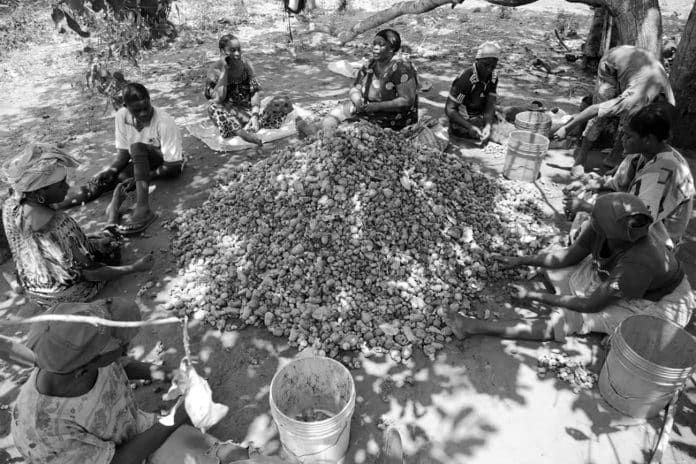Navigating the Price Fluctuations: How Tanzania’s Raw Cashew Price Impacts the Global Cashew Industry
In the world of cashews, Tanzania plays a crucial role as one of the leading producers and exporters. However, the price fluctuations of raw cashews in Tanzania have far-reaching consequences that extend beyond its borders. The global cashew industry heavily relies on Tanzania’s cashew production, making it essential to understand how these price fluctuations impact the market. This article will delve into the dynamics of Tanzania raw cashew price and its ripple effects on the global cashew industry. We will explore the factors influencing the price fluctuations, the challenges faced by both producers and buyers, and the strategies employed to navigate this volatile market. So, whether you’re a cashew enthusiast, a cashew farmer, or a cashew trader, this article will provide valuable insights into the intricate world of cashew pricing and its significance for the global cashew industry.
The Importance of Tanzania in the Global Cashew Industry
Tanzania is known for its vast cashew plantations, making it a significant player in the global cashew industry. The country’s favorable climate and fertile soil provide ideal conditions for cashew cultivation, resulting in high-quality raw cashews. Tanzania’s cashew production contributes significantly to the global supply, with its exports reaching various corners of the world. The demand for cashews continues to rise, driven by their nutritional value and increasing popularity as a healthy snack. As a result, Tanzania’s role in meeting this demand cannot be overstated.
The global cashew industry relies on Tanzania’s cashew production for a steady supply of raw cashews and this reliance has tremendous effects on Tanzania raw cashew price. Cashews are a versatile ingredient used in various food products, including snacks, desserts, and even as a dairy alternative in plant-based milk. Additionally, cashews are a valuable commodity in the cosmetics industry, where they are used in the production of skincare products. Tanzania’s cashew exports serve as a crucial raw material for these industries, contributing to their growth and economic viability.
However, the price fluctuations of Tanzania’s raw cashews pose challenges for both producers and buyers in the global cashew industry. Understanding the factors driving these fluctuations is essential to navigate this complex market successfully.
Factors Influencing Tanzania’s Raw Cashew Price
Several factors influence the price of raw cashews in Tanzania. These factors interact in a complex manner, creating a volatile market environment that requires constant monitoring and adaptation. Let’s explore some of the key factors impacting Tanzania raw cashew price:
- Weather conditions: Tanzania’s cashew plantations are susceptible to changes in weather patterns. Droughts, floods, or other extreme weather events can significantly impact crop yields and quality. When weather conditions are favorable, cashew production increases, leading to a surplus supply that may drive prices down. Conversely, adverse weather conditions can reduce yields, resulting in a scarcity of raw cashews and driving prices up.
- Global demand: The global demand for cashews is a crucial factor influencing Tanzania’s raw cashew price. As the demand for cashews grows in various industries, including food, cosmetics, and pharmaceuticals, the pressure on Tanzania’s cashew production increases. Higher demand often leads to an increase in prices, as buyers compete for limited supplies. Conversely, a decrease in demand may result in a surplus of cashews, leading to lower prices.
- Export policies and regulations: Government policies and regulations related to cashew exports can have a significant impact on Tanzania’s raw cashew price. Export restrictions, tariffs, or changes in trade agreements can disrupt the supply chain and affect the pricing dynamics. Political stability and a favorable business environment are crucial for maintaining a consistent flow of cashew exports and stable prices.
Understanding these factors is crucial for market participants to anticipate and adapt to price fluctuations effectively.

Historical Trends in Tanzania’s Raw Cashew Price
Analyzing the historical trends in Tanzania raw cashew price provides valuable insights into the market dynamics and helps identify patterns that can guide future strategies. Over the years, Tanzania’s raw cashew price has experienced both significant fluctuations and periods of relative stability.
Between 2010 and 2015, Tanzania witnessed a steady increase in raw cashew prices. This rise was primarily driven by increased demand from emerging markets and the growing popularity of cashews as a healthy snack. During this period, Tanzania’s cashew farmers enjoyed higher prices, encouraging further investment and expansion of cashew plantations.
However, starting from 2016, Tanzania raw cashew price experienced a sharp decline. A combination of factors, including unfavorable weather conditions and a decrease in global demand, led to an oversupply of cashews. As a result, prices plummeted, causing financial challenges for cashew farmers and exporters.
In recent years, Tanzania’s raw cashew price has shown signs of recovery. The global demand for cashews has been steadily increasing, driven by changing consumer preferences and the rise of the health food industry. This upward trend in demand has led to a more favorable pricing environment for Tanzania’s cashew producers.
Impact of Tanzania’s Raw Cashew Price on the Global Cashew Industry
Tanzania raw cashew price have a significant impact on the global cashew industry. As one of the leading cashew producers, Tanzania’s pricing dynamics influence the overall market sentiment and pricing trends. Let’s explore some of the key impacts:
- Price stability: Tanzania’s cashew price fluctuations can create instability in the global cashew market. When prices are volatile, buyers and sellers face uncertainty, making it challenging to plan and negotiate contracts. Price stability is crucial for maintaining a healthy and sustainable cashew industry.
- Profit margins: The price of raw cashews directly impacts the profit margins of cashew farmers, processors, and traders. When prices are low, farmers may struggle to cover their production costs, leading to reduced profitability and potential financial hardships. Conversely, higher prices can improve profit margins but may also increase the cost of raw materials for cashew processors and manufacturers.
- Investment and expansion: The stability and predictability of Tanzania’s raw cashew price influence investment decisions and the expansion of cashew plantations. When prices are favorable, farmers and investors are more likely to allocate resources towards cashew cultivation, leading to increased production capacity. Conversely, uncertain or low prices may discourage new investments and limit the industry’s growth potential.
- Competitive positioning: Tanzania’s cashew price impacts the competitiveness of other cashew-producing regions. When Tanzania’s prices are low, it can put pressure on other producers to match or lower their prices to remain competitive. This dynamic can create a race to the bottom, affecting the profitability and sustainability of cashew production in various regions.
Navigating these impacts requires a proactive approach and strategic decision-making by market participants across the cashew value chain.
Strategies for Navigating Price Fluctuations in the Cashew Industry
Given the inherent volatility in Tanzania raw cashew price, market participants in the cashew industry employ various strategies to navigate price fluctuations effectively. Let’s explore some of the key strategies:
- Diversification: Cashew farmers and traders can diversify their product offerings to mitigate the risks associated with price fluctuations. This can include expanding into value-added cashew products, such as roasted cashews, cashew butter, or cashew-based snacks. Diversification helps reduce reliance on raw cashew prices alone and provides additional revenue streams.
- Supply chain optimization: Optimizing the cashew supply chain is crucial for managing price fluctuations. This includes streamlining logistics, improving storage facilities, and implementing efficient transportation systems. By reducing wastage and minimizing delays, market participants can better respond to changing market conditions and secure better pricing opportunities.
- Long-term contracts: Establishing long-term contracts with buyers or suppliers can provide stability to cashew producers and traders. These contracts can include fixed pricing arrangements or price adjustment mechanisms based on predefined factors such as market conditions or production costs. Long-term contracts provide predictability and reduce the exposure to short-term price fluctuations.
- Market intelligence: Staying informed about market trends, global demand, and competitor strategies is crucial for making informed decisions. Market intelligence helps identify emerging opportunities, anticipate price trends, and adapt to changing market dynamics. Access to reliable data and analysis is essential for market participants to navigate price fluctuations effectively.
Future Outlook and Predictions for Tanzania’s Raw Cashew Price
Predicting the future of Tanzania raw cashew price is challenging due to the complex interplay of various factors. However, certain trends and projections can provide insights into the potential direction of the market.
- Increasing global demand: The global demand for cashews is expected to continue its upward trajectory, driven by changing consumer preferences and the rise of the health food industry. This increased demand may put upward pressure on Tanzania’s raw cashew price, benefiting cashew farmers and exporters.
- Climate change impact: Climate change poses a significant risk to Tanzania’s cashew production. Extreme weather events, such as droughts or floods, can disrupt crop yields and quality, affecting the supply and pricing dynamics. Sustainable farming practices and investments in climate resilience will be crucial to mitigate these risks and ensure the long-term viability of Tanzania’s cashew industry.
- Trade policies: Changes in trade policies, including tariffs and trade agreements, can have a significant impact on Tanzania’s cashew exports and pricing. Continued efforts to promote fair trade practices and open markets are essential for maintaining a stable and predictable pricing environment.
While the future of Tanzania’s raw cashew price remains uncertain, proactive measures and strategic planning will be critical for market participants to navigate the challenges and seize opportunities.
Conclusion: The Need for a Proactive Approach in the Global Cashew Industry
Tanzania raw cashew price fluctuations have far-reaching consequences for the global cashew industry. Understanding the factors influencing these price fluctuations, analyzing historical trends, and implementing effective strategies are essential for market participants to navigate this complex market successfully.
By diversifying product offerings, optimizing supply chains, establishing long-term contracts, and leveraging market intelligence, cashew farmers, processors, and traders can mitigate the risks associated with price volatility and position themselves for sustainable growth.
As the global demand for cashews continues to rise, Tanzania’s role in the cashew industry will remain crucial. Proactive decision-making, adaptability, and collaboration across the cashew value chain will be key to ensuring a stable and thriving global cashew industry. So whether you’re a cashew enthusiast, a cashew farmer, or a cashew trader, understanding and navigating Tanzania raw cashew price fluctuations is essential for long-term success in this vibrant industry.
Happy cashew journey!
For more Cash Crops in Tanzania articles click here!

































